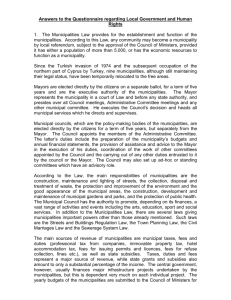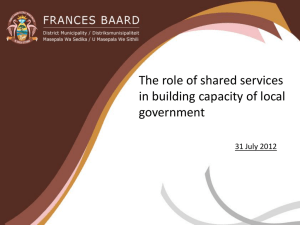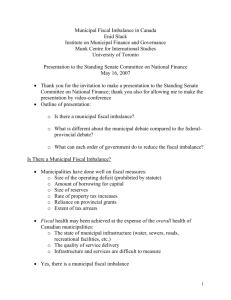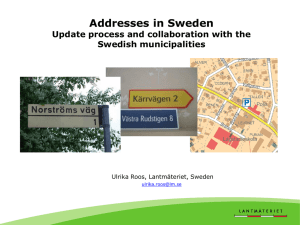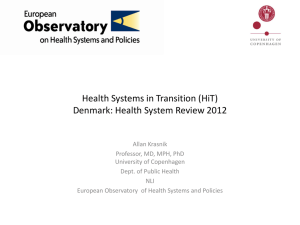Outcome 09 Local Government - POA
advertisement
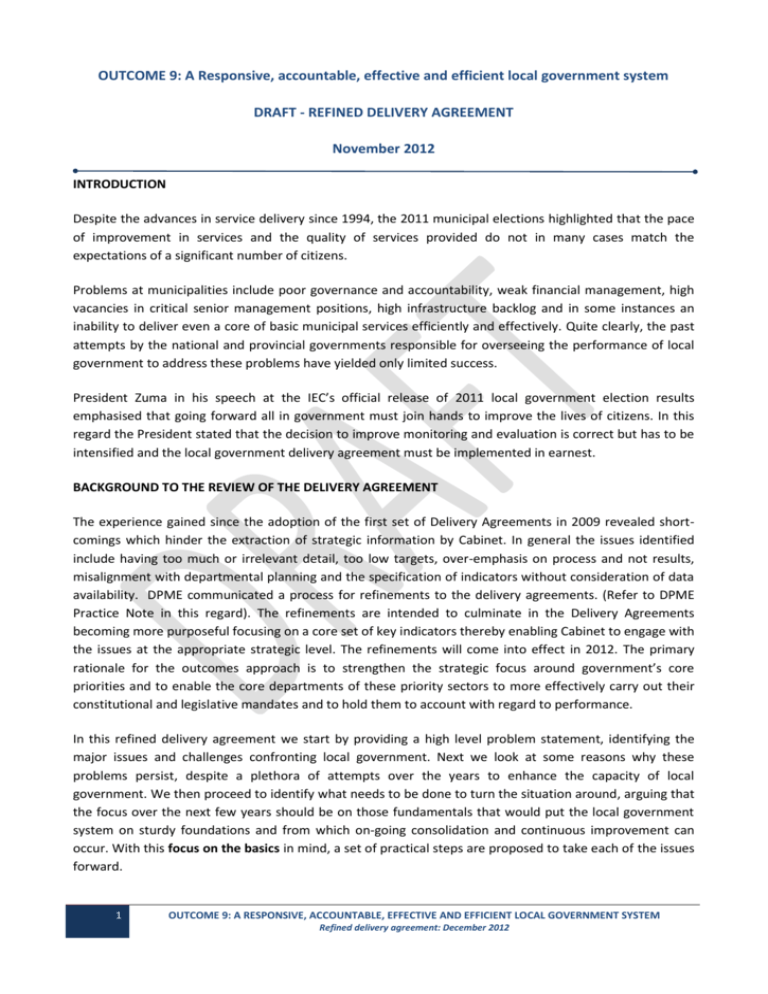
OUTCOME 9: A Responsive, accountable, effective and efficient local government system DRAFT - REFINED DELIVERY AGREEMENT November 2012 INTRODUCTION Despite the advances in service delivery since 1994, the 2011 municipal elections highlighted that the pace of improvement in services and the quality of services provided do not in many cases match the expectations of a significant number of citizens. Problems at municipalities include poor governance and accountability, weak financial management, high vacancies in critical senior management positions, high infrastructure backlog and in some instances an inability to deliver even a core of basic municipal services efficiently and effectively. Quite clearly, the past attempts by the national and provincial governments responsible for overseeing the performance of local government to address these problems have yielded only limited success. President Zuma in his speech at the IEC’s official release of 2011 local government election results emphasised that going forward all in government must join hands to improve the lives of citizens. In this regard the President stated that the decision to improve monitoring and evaluation is correct but has to be intensified and the local government delivery agreement must be implemented in earnest. BACKGROUND TO THE REVIEW OF THE DELIVERY AGREEMENT The experience gained since the adoption of the first set of Delivery Agreements in 2009 revealed shortcomings which hinder the extraction of strategic information by Cabinet. In general the issues identified include having too much or irrelevant detail, too low targets, over-emphasis on process and not results, misalignment with departmental planning and the specification of indicators without consideration of data availability. DPME communicated a process for refinements to the delivery agreements. (Refer to DPME Practice Note in this regard). The refinements are intended to culminate in the Delivery Agreements becoming more purposeful focusing on a core set of key indicators thereby enabling Cabinet to engage with the issues at the appropriate strategic level. The refinements will come into effect in 2012. The primary rationale for the outcomes approach is to strengthen the strategic focus around government’s core priorities and to enable the core departments of these priority sectors to more effectively carry out their constitutional and legislative mandates and to hold them to account with regard to performance. In this refined delivery agreement we start by providing a high level problem statement, identifying the major issues and challenges confronting local government. Next we look at some reasons why these problems persist, despite a plethora of attempts over the years to enhance the capacity of local government. We then proceed to identify what needs to be done to turn the situation around, arguing that the focus over the next few years should be on those fundamentals that would put the local government system on sturdy foundations and from which on-going consolidation and continuous improvement can occur. With this focus on the basics in mind, a set of practical steps are proposed to take each of the issues forward. 1 OUTCOME 9: A RESPONSIVE, ACCOUNTABLE, EFFECTIVE AND EFFICIENT LOCAL GOVERNMENT SYSTEM Refined delivery agreement: December 2012 Given the emphasis on getting back to the basics and fundamentals, the review was informed by the following principles: Solutions lie not in one simple remedy, but in sustained implementation of a combination of actions Success is also not about having some grand plan at the beginning, but having a clear sense of what we can do first to unleash a series of positive forces that will place local government on a path of continuous and sustained improvement. That means we can’t do everything and some tough choices have to be made regarding which key variables we need to focus on and how to sustain focus on these. 1. HIGH LEVEL PROBLEM STATEMENT Local government is a key part of the reconstruction and development effort of our country. The aims of democratising our society and bringing about a growing inclusive economy can only be realised through a responsive, accountable and efficient local government system. However, 12 years into the new local government system, a significant number of municipalities are in deep distress. An assessment by the Department of Cooperative Governance (DCoG) in 2009 found 115 local municipalities and 23 district municipalities to be either highly or very highly vulnerable. These municipalities are mainly located in areas of high poverty concentration (socio-economic vulnerability) with significant services backlogs (institutional vulnerability). A strong correlation therefore exists between socio-economic vulnerability and institutional vulnerability with institutional vulnerability most pronounced in rural municipalities and those localities that have only one or two small towns. While access to basic services has progressively risen, the backlogs remain high. Nationally as many as 46% (or 5.7 million) of households did not have universal access to water, sanitation, refuse removal and electricity (i.e. access to basic and higher levels of service in respect of all four services) in 2009. Table 1: Universal Access to Basic Services Province Indicator Western Cape Universal basic access % 88% National Rank 1 Universal or higher access % 83% Gauteng 79% 2 75% Northern Cape 71% 3 62% Free State 60% 4 53% Kwa-Zulu Natal 45% 5 38% Mpumalanga 40% 6 34% North West 38% 7 34% Eastern Cape 33% 8 29% Limpopo 15% 9 13% Performance Levels: 60% - 89% 30% - 59% 0 – 30% Source: uHabs Index Baseline 2009 2 OUTCOME 9: A RESPONSIVE, ACCOUNTABLE, EFFECTIVE AND EFFICIENT LOCAL GOVERNMENT SYSTEM Refined delivery agreement: December 2012 As can be seen in Table 1 above, Kwa-Zulu Natal, Mpumalanga, North West, Eastern Cape and Limpopo were all below the national average of 46%, with Limpopo recording the lowest in terms of universal access to basic services. In this province, 85% of households did not have universal access in 2009. Current evidence shows that there are 23 Districts (see table 2) where lack of access is most acute. These districts account for the highest concentration of backlogs. Clearly there is in a number of instances an inability on the part of many municipalities to deliver even a core set of critical municipal services efficiently and effectively. Table 2: 21 Districts with largest number of households without access % HH with NO ACCESS1 Basic Services PROVINCE Water Sanitation Electricity 1. Alfred Nzo 16.6% 15.5% 64.9% 2. OR Tambo 18.9% 18.4% 37.9% 3. Chris Hani 8.0% 27.6% 27.5% 4. Joe Gqabi/ Ukhahlamba 17.2% 37.4% 45.3% 5. Amathole 6.1% 25.1% 38.9% 6. John Taolo Gaetsewe 21.1% 27.9% 0.0% 7. Greater Sekhukhune 12.6% 38.0% 21.7% 8. Capricon 12.2% 39.1% 26.5% 9. Vhembe 18.8% 54.3% 26.7% 10. Mopani 18.0% 44.9% 20.3% 11. Ngaka Modiri Molema 11.7% 34.0% 22.4% 12. Dr. Ruth Segomotsi Mompati 20.9% 28.2% 17.4% 13. Zululand 6.0% 31.3% 17.6% 14. Sisonke 22.6% 22.2% 54.0% 15. Amajuba 21.7% 15.3% 23.9% 16. uThukela 26.5% 20.7% 31.3% 17. Ugu 29.7% 8.5% 43.1% 18. uMkhanyakude 34.2% 29.4% 75.9% 19. iLembe 18.6% 19.3% 43.2% 20. Umzinyathi 10.0% 27.1% 24.0% 21. uThungulu 12.8% 29.2% 41.8% Mpumalanga 22. Ehlanzeni 11.8% 37.2% 24.1% Free State 23. Xariep (DC16) 0.0% 26.3% 23.2% Eastern Cape Northern Cape Limpopo North West Kwa-Zulu Natal Poor governance and accountability are also a major concern. These are partially manifested in the high levels of distrust in local government and escalation in community protests. Various polls (HSRC, Markinor) 1 Information on access to refuse removal not available as yet. 3 OUTCOME 9: A RESPONSIVE, ACCOUNTABLE, EFFECTIVE AND EFFICIENT LOCAL GOVERNMENT SYSTEM Refined delivery agreement: December 2012 show that the level of trust in local government has declined sharply since 2004 (see graph below). Municipalities were envisioned as sites where our commitment to participatory governance would achieve meaning and content. Instead, communities feel alienated and disconnected from decision-making processes and feel disempowered in influencing the affairs of the municipality. Much of this stems from poor communication with communities, lack of transparency, and weak and ineffective ward committees. The state of financial governance and management shows that much still needs to be done and a number of challenges remain. For instance, audit reports for 46 municipalities were not issued by 31 January 2011 for the 2009-10 financial year, compared to 3 in 2008-09. The Auditor General reports also show that 120 municipalities received unqualified audits in 2009-10, compared to 113 in 2008-09. This shows some improvement. However financial audits do not show the full picture regarding the financial position of municipalities. Cash flow figures show that over 60% of municipalities had less than one month’s cash coverage for operational expenses, outstanding debt to municipalities has risen sharply and National Treasury data show that in 2011 about 20% of municipalities have debtor levels higher than 50% of their own revenue. There is also significant under-expenditure with regard to capital budgets (67% of municipalities), over-expenditure on operating budgets and under-budgeting for repairs and maintenance (it is estimated that 92% of municipalities spend less than 5% of their budgets on repairs and maintenance). This provides clear evidence that financial management is poor and controls are currently inadequate or absent in a large proportion of municipalities. Municipal capacity to deliver is also severely constrained by high vacancy rates and a lack of suitably qualified individuals in senior positions. The service delivery protests are one signal that the failings in local government cannot go unchecked. In combination, all the problems described above have shattered the confidence of the majority of our people in our local government system. 1.1. WHY DO THE PROBLEMS PERSIST One of the key findings of the South African Human Rights Commission arising from the open toilets saga in Makhaza and Moqhaka in 2010 was that despite legislative and constitutional provisions, provincial and 4 OUTCOME 9: A RESPONSIVE, ACCOUNTABLE, EFFECTIVE AND EFFICIENT LOCAL GOVERNMENT SYSTEM Refined delivery agreement: December 2012 national departments responsible for local government have not adequately supported and monitored the performance of local government. Within the framework of cooperative governance, the Constitution obliges national and provincial governments to support and strengthen the capacity of municipalities to manage their own affairs, to exercise their powers and to perform their functions. Legislative responsibility for monitoring the performance of local government resides with national DCOG and the provincial Departments of Local Government. Sections 47 and 48 of the Local Government Municipal Systems Act 32 of 2000 respectively compel the MEC for local government and the Minister to compile annual reports of municipal performance. National Treasury is required in terms of the Constitution to promote and enforce national norms and standards relating to budgeting accounting, procurement and other financial management matters in local government. Despite the plethora of capacity building and support activities of national and provincial departments over the past 10 years, many municipalities are still in deep distress. The question of why all of these initiatives have produced less than optimal results is valid? The general view is that it is largely due to a lack of focus – past attempts have lacked a structured and coherent approach to developing municipal capacity, and the temptation has been to produce a shopping list of actions. As a consequence, effort and energy is distributed on a broad front and overall impact is diffused and minimal. A further reason for the limited success of past attempts to improve the performance of local government stemmed from the fact that we tended to treat all municipalities as uniform, undifferentiated entities. This was clearly a mistake and it is now recognised that municipalities have different capacities and their social and economic contexts also vary. Our response to turn around local government should thus be tailored to the different contexts prevailing in different municipalities. An additional explanation for the limited success was the inability of the national government departments that impact local government to develop a cohesive plan and fully co-operate to ensure a unified approach in their engagements with municipalities. The problem of coordination and alignment of interventions of departments and agencies impacting on local government remains a massive challenge. 2. DELIVERY PARTNERS AND THEIR ROLES AND RESPONSIBILITIES 2.1. NATIONAL DEPARTMENTS There is a core of National Departments2 that have a direct impact on municipalities. It is imperative that their roles and responsibilities are clearly defined and mechanisms are created to better coordinate and align their various initiatives. The core departments are DCOG, National Treasury, Water Affairs, Human Settlements, Energy, Rural Development and Land Reform, Transport, The Presidency and Environment. These departments will have to establish a closer working relationship to jointly tackle the following matters at the minimum: Coordination of infrastructure funding flows to unlock delivery of services; Coordinate human settlement planning and service delivery planning; Evaluate and coordinate capacity building initiatives to ensure greater impact and together with this develop a national skills development programme to build up the skills base for critical skills areas in the local government sphere; Rationalise municipal reporting requirements; 2 The precise responsibilities of various partners are described under each output. 5 OUTCOME 9: A RESPONSIVE, ACCOUNTABLE, EFFECTIVE AND EFFICIENT LOCAL GOVERNMENT SYSTEM Refined delivery agreement: December 2012 Liaise with their sector and better organise intergovernmental support to municipalities, e.g. Department of Water Affairs working with their Regional Offices, Provinces, and Water Service Authorities regarding water access and management; Work with their Provincial Sector Departments to support and monitor the interventions agreed upon, including: - Promoting sound oversight practices by municipal council, through training and better oversight; - Strengthening the institutional capacity of municipalities by monitoring compliance with local government legislations; - Strengthening budgeting, supply chain management and other financial management practices 2.2 PROVINCIAL ROLES AND RESPONSIBILITIES Each province will develop a province specific implementation support plan based on the Outcome 9 Delivery Agreement, and establish the planning, management and administrative apparatus to fulfil provincial delivery commitments as well as the monitoring and accurate reporting thereof. A key role of the provinces in the implementation of Outcome 9 is to undertake critical support, monitoring, and reporting roles based on their provincial-specific municipal implementation support plan related to the outputs and targets agreed to in this agreement. This will include: i. ii. iii. Alignment with the National Government approach and national Delivery Agreement and similarly undertake the applicable actions at a provincial level. In particular applying and contextualising the delivery agreement to the provincial context by specifying provincial commitments to the national outputs and targets. Allocation of more and appropriate resources towards the Local Government function within provinces to bring about Better spending and outcomes in municipalities Alignment and resource commitments of provincial departments in IDPs Promoting sound oversight practices by municipal council, through training and better oversight; Strengthening the institutional capacity of municipalities by monitoring compliance with local government legislations; Strengthening budgeting, supply chain management and other financial management practices Strengthen the provision and coordination of capacity support to municipalities by ramping up provincial capacity to monitor and render support to municipalities. Monitoring and reporting on the implementation of targets and activities 2.3 MUNICIPAL ROLES AND RESPONSIBILITIES 6 OUTCOME 9: A RESPONSIVE, ACCOUNTABLE, EFFECTIVE AND EFFICIENT LOCAL GOVERNMENT SYSTEM Refined delivery agreement: December 2012 Municipalities are the key delivery partners in the field of implementation. As with organizational performance management systems, the performance management system of government will cascade from the Presidency to the smallest municipality. 2.4 ROLE OF DCOG AS COOR DINATING DEPARTMENT As coordinating department it is DCoG’s primary responsibility to ensure that partners understand their roles and responsibilities in the delivery agreement, that the partners fulfil their commitments and obligations for their respective outputs and or sub-outputs and that the gathering of information from partners to ensure timely and accurate reporting of progress is coordinated. 3. OUTCOME STATEMENT: By responsive, accountable, effective and efficient local government system we envision a system of local government that recognises that municipalities operate in varied contexts and have differing capacities and therefore tailors planning, financing and support to the specific requirements of different municipalities and that ensures sustainable access to essential services and quality neighbourhoods, initiates ward-based programmes to sustain livelihoods for the poor, strengthens local democratic participation and that demonstrates effective administrative and financial capabilities. To achieve the above vision it is critical to achieve focus and sustain action on a set of high impact areas to drive major change and reforms over the medium-term. In this regard the following 7 critical issues require attention: 1. Adopt a policy framework that recognises the varied contexts and capacities and provides for appropriate differentiation to municipal planning, financing and support. 2. Ensure improved access to essential services 3. Initiate ward-based programmes to sustain livelihoods in targeted poor communities 4. Contribute to the achievement of sustainable human settlements and quality neighbourhoods 5. Strengthen participatory governance 6. Strengthen the administrative and financial capability of municipalities 7. Address coordination problems and strengthen cross-departmental initiatives The idea is to set clear direction and a consistent sense of urgency with regard to the issues listed above in terms of outputs, indicators, targets and roles and responsibilities. 4. WHAT NEEDS TO BE DONE –LINKING OUTPUTS TO THE OUTCOME STATEMENT Rationale for focusing on the 7 issues Apartheid divided South Africa into separate and unequal spaces and that design remains imprinted on settlements throughout the country. These marked differences in poverty, wealth and institutional capacity The 283 municipalities in South Africa function in very different contexts, as a result they have differing institutional and fiscal capacities. These differences need to be explicitly recognised when national and provincial government develop policies relating to local government. To achieve this, it will require better 7 OUTCOME 9: A RESPONSIVE, ACCOUNTABLE, EFFECTIVE AND EFFICIENT LOCAL GOVERNMENT SYSTEM Refined delivery agreement: December 2012 information on local government and a more rigorous analysis of such information depending on the issue that need intervention (planning, financing and support).There is clear and demonstrable progress made by local government in accelerating access to basic services for the poor. Yet, there is considerable scope for further improvement in both the quantity and quality of provision considering the size of the services backlog that remains and the demand pressures emanating from population and economic growth. As part of our response to tackle poverty and provide livelihood support for poor households, government adopted the Community Work Programme (CWP). This programme is a key initiative to mobilize communities in order to provide regular and predictable work opportunities at the local level. This is a ward-based programme, which involves: identifying ‘useful work’ ranging from 1- 2 days a week or one week a month initially targeted at the poorest wards; and creating access to a minimum level of regular work for those who need it, targeting areas of high unemployment and poverty, where sustainable alternatives are likely to remain limited for the foreseeable future. The spatial form of our towns and cities are characterized by sprawl and the apartheid legacy of marginalizing the poor to areas far from opportunities is very much in evidence. In this regard National and provincial departments of local government will play an active role in supporting Outcome 8 which is coordinated under the auspices of the Department of Sustainable Human Settlements. There are 4277 wards demarcated wall-to-wall within the eight metropolitan, 46 district municipalities and 229 local municipalities of South Africa. The wards form the basic units for participatory and democratic local government. However, there are serious challenges with regard to the effectiveness of the Ward Committee System in enhancing the involvement of communities in meaningful local decision-making. It is therefore critical to strengthen our people-centred approach to governance and development and deepen democracy. Poor administrative and financial management and the lack of effective controls and accountability systems impacts negatively on service delivery to communities, from the lack of provision of water and other services to inadequate funds for technical equipment for servicing basic infrastructure. The ineffective management of many municipalities has been attributed to a combination of factors - from the improper political and administrative interface to weak institutional arrangements and poor supervision and accountability mechanisms. The implementation of sound administrative and financial management practices as set out in the local government framework legislation remains a challenge in many municipalities. Going forward it will be critical to focus our attention on improving the financial and administrative capabilities of municipalities. The tasks of tackling the varied problems facing municipalities are cross cutting and complex. This will require creative and innovative organisational forms intended to bring key departments together to facilitate cross departmental collaborative partnerships to impact more decisively and positively on municipal performance. The key task is to better align and coordinate the varied interventions of departments and agencies impacting on local government and provide for more focused oversight and support to municipalities. To achieve this, it is critical that the specific roles and responsibilities of different 8 OUTCOME 9: A RESPONSIVE, ACCOUNTABLE, EFFECTIVE AND EFFICIENT LOCAL GOVERNMENT SYSTEM Refined delivery agreement: December 2012 sectors that interact with local government are clearly defined and respected. This will lay a foundation for cooperation between sectors and ensure accountability. Given the above, the performance agreement between the President and Minister DCoG identified seven outputs corresponding to the 7 key issues. These are: Output 1: A policy Framework that provides for a differentiated approach to municipal financing, planning and support is implemented Output 2: Improved Access to Basic Services. Output 3: Implementation of the Community Work Programme Output 4: Outcome 8 on sustainable human settlement is supported Output 5: Local democracy through a refined Ward Committee model is deepened Output 6: Administrative and financial capabilities of municipalities are enhanced Output 7: Improved coordination of interventions impacting on local government 4.1. OUTPUT 1: A POLICY FRAMEWORK THAT PROVIDES FOR A DIFFERENTIATED APPRO ACH TO MUNICIPAL FINANCING, PLANNING AND SUPPORT IS IMPLEMENTED Output aspiration: The one size fits all approach to local government has not worked. As such there is a need for a coherent policy framework that responds to the varied social, economic, technical and administrative context of municipalities so that planning, financing and support is tailored to the unique context within and conducive to the requirements of different municipalities. Moreover the Integrated Development Plans of municipalities were meant to be the linchpins for facilitating local development and service delivery. Many have not however lived up to this promise. Without viable planning frameworks municipal service delivery will continue to be ineffective, ad-hoc and unresponsive to the pressing needs of communities. The key focus is to get back to the basics and assist and support all municipalities outside of the major metros and secondary cities to focus their IDPs on the delivery of a floor of priority services. Additionally and in tandem the same municipalities should be assisted and supported to ensure their budgets have clear links to the IDP and reflects the priorities in the IDP. The support that municipalities need is not about some grand plan, but having a clear sense of what we can do first to turn local government around and put onto a virtuous cycle of continuous improvement. Given the above output 1 has 2 sub-outputs: Sub-output 1: 9 Government position on the differentiated approach to local government supported by a framework that will enable data driven decision making to differentiate municipalities in terms of their different contexts and capacities. The target time frame to finalise the framework is 2012/13 financial year. OUTCOME 9: A RESPONSIVE, ACCOUNTABLE, EFFECTIVE AND EFFICIENT LOCAL GOVERNMENT SYSTEM Refined delivery agreement: December 2012 Sub-output 2: All municipalities outside of the metros and secondary cities have IDPs that focus on set of priority services and are clearly linked to budgets. The target is focused IDPs linked to budgets for essential services implemented in the selected municipalities by 2014. The key activities to achieve the sub-outputs are as follows: Sub-output 1 – key activities (Responsible department/s: DCoG partnering with National Treasury) i. ii. Develop a framework that will enable data driven decision making to support the government position on the differentiated approach to local government Review and amend the framework for powers and functions for provincial and local government with recommendations for differentiation and functional and fiscal alignment Sub-output 2 – key activities (Responsible department/s: DCoG) i. Develop a revised IDP framework focused on a floor of key priority services. ii. Engage provinces to implement the IDP framework in targeted municipalities. iii. Monitor and review quality of IDPs and their links to budgets and take corrective actions. 4.2. OUTPUT 2: IMPROVED ACCESS TO BASIC SERVICES We have very ambitious targets regarding access to essential services. To succeed we have to have a very clear idea of how we intend to achieve the targets. It is widely agreed that the biggest constraint is availability of infrastructure and the application of appropriate delivery technologies in remote rural areas. The enormity of the task requires us to be systematic. To respond to this complexity, the key departments impacting on services must be brought together to coordinate and integrate their interventions. Output aspiration: To ensure universal access to basic services by all citizens. The key enabling activity is that each service sector (water, sanitation, electricity, refuse removal and waste management and public roads) should organise itself into a service delivery management structure to plan and implement the delivery of basic services. The respective delivery management structures should report to the Human Settlements and Basic Services Task Team (HS&BS TT) comprising the Departments of Human Settlements, DCoG, Water Affairs, Rural Development and Land Reform, National Treasury, Energy, Transport, Public Works, Environmental Affairs, NPC, PME, Provincial Departments of Local Government, Metros, SALGA, DBSA, Housing Development Agency. The role of the HS&BS TT is to coordinate and integrate the sectoral initiatives and interventions, track progress and address blockages. The National Municipal Capacity Co-ordination Committee, Cities Support Programme (to be established by National Treasury) and Municipal Infrastructure Support Agency (to be established within DCoG) will be the key resources to the sector based delivery management structures. Given the above, output 2 has one sub-output with associated targets: 10 OUTCOME 9: A RESPONSIVE, ACCOUNTABLE, EFFECTIVE AND EFFICIENT LOCAL GOVERNMENT SYSTEM Refined delivery agreement: December 2012 Sub-output 1: Service delivery backlogs for each sector are mapped and projects and funding coordinated per municipality to improve access to basic services to achieve the following 2014 targets: a. 100% of households have access to basic level of water b. 100% households have access to basic level of sanitation c. 75% of households have access to basic level of refuse removal d. 92% of households have access to electricity Responsible departments: Sector departments (DWA, DHS, DEA and DE) responsible for their relevant sectors supported by MISA within DCoG. The key activities for each of the above sectors to achieve the sub-output are as follows: i. ii. iii. iv. v. vi. Establish a service delivery management structure for each sector supported by MISA. Memorandum of understanding amongst key participants and terms of reference for service delivery management structure developed for each sector Establish service delivery norms and standards for basic services and determine and quantify service backlogs per municipality according to these norms and standards Determine and agree on a portfolio of investments needed to overcome the backlogs per municipality Assign responsibility for the projects, coordinate investment planning (prioritising, scheduling and sequencing) as well as the various grant mechanisms to deliver the projects (i.e. prepare an infrastructure capital and maintenance plan for each municipality) Develop and implement mechanisms to support municipalities to plan, implement and operate and maintain municipal infrastructure projects where capacity is weak (i.e. an institutional and financial plan for the municipality). Use the Department of Water Affairs ‘business attributes approach’ as a model. Establish a focused information and programme management and monitoring system The above work will initially focus on the 23 districts with the highest backlogs in services and progressively rolled out to other municipalities. 4.3. OUTPUT 3: IMPLEMENTATION OF TH E COMMUNITY WORK PROGRAMME High levels of poverty persist and massive job losses have occurred as a result of the global economic crisis and the resultant impact on the domestic economy. In this regard, localities are differentially affected. It is therefore important that we localise public employment initiatives, targeting areas of high poverty and unemployment to enable poor households to access regular work and income. The CWP is a key initiative to mobilize communities in order to provide regular and predictable work opportunities at the local level. This is an area-based programme, which involves identifying ‘useful work’ ranging from 1- 2 days a week or one week a month targeted at the poorest wards. 11 OUTCOME 9: A RESPONSIVE, ACCOUNTABLE, EFFECTIVE AND EFFICIENT LOCAL GOVERNMENT SYSTEM Refined delivery agreement: December 2012 Output aspiration: Creating access to a minimum level of regular work for those who need it, targeting areas of high unemployment and poverty and where sustainable alternatives are likely to remain limited for the foreseeable future. Output 3 has 2 sub-outputs Sub-output 1: Participation rate of 332 500 achieved in 228 sites of which 253 360 are work opportunities at 100 days per year by 2014/2015 financial year. Sub-output 2: The CWP expands to a participation rate of 1 million by identifying the work programmes that will deliver this result, the sources and modalities for funding an expanded programme of this scale and the institutional design and intergovernmental collaboration that will be needed to deliver the programme as a government wide initiative. Responsible department/s: DCoG and National CWP Steering Committee The key activities to drive these sub-outputs are as follows: Sub-output 1 - key activities: i. Efficient management arrangements and institutional model in place ii. From the existing 2011/12 base of 74 sites, reduce through consolidation existing 74 sites to 68, establish 80 new inception sites to achieve a participation of 1000 participants and use the balance of funds to scale up existing sites to between 1 500 and 3 000 participants per site in 2012/13. iii. Consolidate and maintain the 80 new sites and existing sites (148 sites in total) during 2013/14. iv. In 2014/15 establish 80 new sites and scale these up to 1 000 participants per site, scale up all other sites at the scale required to achieve the participation rate target of 332 500. Sub-output 2 – key activities i. Establishment of a National Steering Committee that provides strategic direction to the CWP, facilitates intergovernmental memoranda of agreements to broaden participation by other government departments and monitors and advises on operations. ii. Steering Committee to oversee and develop a business plan for scaling up the CWP to a potential participant rate of 1 million participants for presentation to the Deputy President’s IMC on public employment programmes and Cabinet. iii. Undertake an institutional review for scaling up and present to DP IMC for adoption 4.4. OUTPUT 4: OUTCOME 8 ON SUSTAIN ABLE HUMAN SETTLEMEN T IS SUPPORTED Many municipalities have technical and administrative capacity to take responsibility for built environment functions. Housing accreditation is a key first step. The role of provinces is to ensure this accreditation happens. Moreover, from the national level, DHS and NT need to ensure that the Urban Settlement Development Grant (USDG) is extended to the secondary cities. In relation to the informal settlement upgrading programme, the key task is to support targeted municipalities with zoning and township establishment processes as well as the delivery of basic services. Additionally, where the Housing Development Agency (HAD) in consultation with State Owned Enterprises, 12 OUTCOME 9: A RESPONSIVE, ACCOUNTABLE, EFFECTIVE AND EFFICIENT LOCAL GOVERNMENT SYSTEM Refined delivery agreement: December 2012 DPW, DRD&LR, Provinces and municipalities has identified well located public land owned by national government, provinces and municipalities its role is to assist and support the release or acquisition of this land for human settlement purposes. All of these issues; housing accreditation for municipalities, extension of the USDG, informal settlements upgrading, acquisition of well located public land and increasing densities are all amply delineated in the Outcome 8 delivery agreement and as such will be reported on by the Department of Human Settlements as the coordinating department for Outcome 8. This is to avoid duplication of effort and reporting by both DCoG and DHS. Responsible department: DHS through the implementation of Outcome 8. 4.5. OUTPUT 5: DEMOCRACY THROUGH A REFINED WARD COMMITTEE MODEL IS DEEPEN ED Some municipalities are not valuing the inputs of communities in decision-making, are unresponsive to citizens needs and are disconnected from their communities. This undermines local democracy and erodes the legitimacy and credibility of local government. Output aspiration: Strengthening ward committees to fulfil their role as key agents of local democratic participation and ensuring that a coherent two way communication strategy that keeps citizens informed of key issues and developments as well as enables citizens to express their concerns is in place. The output has 2 key sub-outputs: Sub-output 1: Strengthened ward committee system Sub-output 2: Functional ward committees Responsible department: DCoG The key activities to achieve the sub-outputs are as follows: Sub-output 1- key activities i. Undertake regular assessment and facilitate implementation of improvement plans Sub-output 2 – key activities i. Provinces to assist ward committees to develop participatory ward level service improvement plans. The service plan should include such issues as plans to improve the delivery of services, clear curb sides and vacant land, reliability of services, quality of roads, etc. and communication ii. Provinces to frequently monitor the implementation of these plans as well as communication of outcomes etc. to communities 4.6. OUTPUT 6: ADMINISTRATIVE AND F INANCIAL CAPABILITIE S OF MUNICIPALITIES ENHANCED 13 OUTCOME 9: A RESPONSIVE, ACCOUNTABLE, EFFECTIVE AND EFFICIENT LOCAL GOVERNMENT SYSTEM Refined delivery agreement: December 2012 We know from evidence that many municipalities have challenges in this regard. Burgeoning outstanding debt; weak financial governance and administrative management; under-exp on capital budgets; little or no allowance for repairs and maintenance; significant vacancies in critical positions and skills gaps are some of the main challenges facing municipalities. Concerted effort is needed to improve performance in these areas failing which service delivery will surely be compromised. to support improved service delivery. Output aspiration: This output goes to the core of an efficient and effective local government system. Thus its intended aspiration is a local government system that demonstrates sound and sustainable administrative and financial management capabilities. The output has eight sub-outputs and associated targets and activities: Sub-output 1: Improved audit outcomes with the number of municipalities with unqualified audits to increase from 41% to 100% Responsible department: DCoG and National Treasury Key activities: Where practical support municipalities to establish internal audit functions and facilitate the appointment of committees appropriately tailored according to the size of municipal council Assist municipalities to develop action plans to address previous audit outcomes, particularly policies and processes in high risk areas such as procurement (supply chain) and asset management Sub-output 2: All municipalities to Improve average monthly collection rate on billings to a minimum of 90% (excluding arrear amounts) Responsible department: National Treasury and DCoG Key activities: Municipalities monitored and assisted to meet the following requirements: o Cost-reflective tariff structures o All properties accurately captured on cadastral system o Sound billing systems so that all properties are properly billed o Accuracy of meters and correct reading of meters o Accurate and reliable billing systems o Responsive citizen care systems to deal promptly with billing queries and complaints. o Development of credit control and debt collection policies o Updating of indigent policies o Development of by-laws to give effect to policies Sub-output 3: The percentage of municipalities that are overspending on opex to improve from 8% to 4% Responsible department: National Treasury Key activities: Monitor in-year financial reports 14 OUTCOME 9: A RESPONSIVE, ACCOUNTABLE, EFFECTIVE AND EFFICIENT LOCAL GOVERNMENT SYSTEM Refined delivery agreement: December 2012 Review and advise municipalities on expenditure control measures and cost controls Ensure that the Auditor-general audits of overspending is properly classified as unauthorised expenditure Ensure that the resultant unauthorised expenditure is properly investigated in terms of section 32 of the MFMA and is dealt with accordingly Sub-output 4: The percentage of municipalities’ under-spending on capex to be reduced from 63% to 30% Responsible department: National Treasury and MISA Key activities: Assist and support municipalities to develop viable capital infrastructure plans Monitor in-year financial reports Municipalities are advised and supported to improve performance on investment spending Evaluate the design of infrastructure condition grants and introduce incentives that reward effective spending Sub-output 5: The percentage of municipalities with debtors more than 50% of own revenue to be reduced from 24% to 12% Responsible department: National Treasury and DCoG Key activities: Assist municipalities to put in place credit control policy and measures Assist municipalities to prepare and implement viable indigents policies Assist municipalities to recover debt from government spheres, departments and entities Develop a policy guideline for the review of outstanding debt and writing off of debt that is uncollectable Sub-output 6: The percentage of municipalities spending less than 5% of opex on repairs and maintenance to be reduced from 92% to 45% Responsible department: National Treasury and MISA Key activities: Develop and streamline reporting requirements for disclosing expenditure on repairs and maintenance Assist municipalities to map infrastructure networks (location & condition) and develop an asset register Assist municipalities to develop and implement maintenance plans for mapped infrastructure Sub-output 7: Critical posts (Municipal Manager, Chief Financial Officer, Development and Town Planning Services, Engineering Services, Community Services, and Support Services) filled with qualified & competent staff There is incontrovertible evidence that having the right skills is critical to municipal effectiveness yet appointments continue to be made that often sidestep competence, skills gaps exist in 15 OUTCOME 9: A RESPONSIVE, ACCOUNTABLE, EFFECTIVE AND EFFICIENT LOCAL GOVERNMENT SYSTEM Refined delivery agreement: December 2012 important technical and management positions and the country has no coherent human resource development strategy for local government. Responsible department/s: DCoG Key activities: Municipalities assisted and monitored to meet the following requirements: o Develop regulations to map out competency criteria for critical management and technical posts o Monitor municipal compliance as per criteria o Identify municipalities not complying and institute support measures to non-complying municipalities o Provinces to identify reasons for critical vacancies and skills gaps and undertake appropriate supportive actions. o Each province develops a long-term human resource plan to ensure the sustainable supply of key skills required at the municipal level. 4.7. OUTPUT 7: IMPROVED GOVERNMENT COORDINATION OF INTERVENTIONS IMPACTING ON LOCAL The challenges facing municipalities are complex, multi-dimensional and multi-sectoral in nature. Coordination and integration of interventions impacting on local government are weak and current support initiatives by national and provincial government are ineffective or at best have had minimal impact. One of the reasons for lack of coordination and ineffective support is that performance information is dispersed across different entities – National Treasury has financial information, sector departments such as water have service delivery performance information –and as such there is no mechanism that brings together various pieces of key information to form an integrated and holistic picture of the municipality with a view to facilitating coordinated responses be it in terms of support or other interventions. Moreover political oversight structures such as the MinMec, Ministerial Implementation Forum and the President’s Coordinating Council do not have at their disposal critical municipal level information to provide strategic leadership over the local government sector. Output aspiration: To provide for a knowledge and evidence-base to facilitate coordination and strengthen cross-departmental and provincial support initiatives impacting on local government. Responsible departments: DPME and DCoG The output has 2 sub-outputs with associated activities. The sub-outputs are as follows: Sub-output 1: Knowledge and evidence-base to facilitate coordination and cross-departmental interventions and support to municipalities developed. Sub-output 2: Provincial departments of local government supported to contextualise delivery agreement targets and provide focused support to municipalities based on evidence of municipal performance. 16 OUTCOME 9: A RESPONSIVE, ACCOUNTABLE, EFFECTIVE AND EFFICIENT LOCAL GOVERNMENT SYSTEM Refined delivery agreement: December 2012 Sub-output 1 – key activities Develop an information management and performance monitoring tool based on similar tools developed for national and provincial departments to assess municipalities and provide information on a national scale and ranks the performance of municipalities against key indicators. This will at the minimum entail developing a floor of norms and standards of performance for the efficient and effective functioning of local government (administratively, politically and on a set of core municipal services), determine the metrics for measuring performance at these norms, and rank and report on the performance of municipalities against the set norms. DCoG, key departments and institutions and provincial departments responsible for local government to collaboratively test and refine the performance assessment tool Assessment of the quality of the management and administrative practices in municipalities Performance information utilised by national and provincial departments to enable them to support municipalities in identified areas of under-performance Legislative obligations for the production MSA S46 (municipal), S47 (provincial) and S48 (national) annual municipal performance reports administered in a way consistent with the performance assessment tool. Sub-output 2 – key activities Engage provincial departments responsible for local government to develop focused support based on performance evidence. Engage provincial departments responsible for local government to contextualise and apply delivery agreement targets 5. CONCLUSIONS Whilst the solutions to the challenges facing local government do not lie not in one simple remedy, it also does not help to have a shopping list of remedies. The solution lies in the sustained implementation of a combination of focused actions. The delivery agreement comprises 7 key issues to focus on in the period leading up to the end of 2014. It is around these issues that a consistent sense of urgency needs to be created during the second half of the 2009-2014 electoral period. The identified 7 output areas serve as a coherent focal point to drive and monitor municipal performance and to ensure that the national and provincial departments with the Constitutional and legislative mandate to monitor and support municipalities are effectively fulfilling their responsibilities and obligations. Finally, as coordinating department, it is the responsibility of Output Leaders in DCoGto ensure that the various partners to this delivery agreement fulfil their obligations and commitments with respect to each of the outputs and sub-outputs delineated above. This includes the timely collection of information for reporting on progress. 6. OUTCOME 9 DASHBOARD A dashboard has been developed that provides a framework for tracking and reporting progress against the outputs and targets. As such it is intended to serve as a tool for robust deliberations at both the Technical and Ministerial Implementation Forums concerning delivery performance against the outputs and targets and the actions required to address blockages and implementation weaknesses. 17 OUTCOME 9: A RESPONSIVE, ACCOUNTABLE, EFFECTIVE AND EFFICIENT LOCAL GOVERNMENT SYSTEM Refined delivery agreement: December 2012 18 OUTCOME 9: A RESPONSIVE, ACCOUNTABLE, EFFECTIVE AND EFFICIENT LOCAL GOVERNMENT SYSTEM Refined delivery agreement: December 2012
